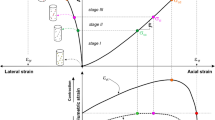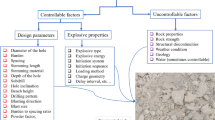Abstract
Determination of the rock elastic parameters is essential in geomechanical studies. Among the elastic parameters, Young’s modulus (YM) and Poisson’s ratio (PR) have many applications in wellbore stability analysis, hydraulic fracturing, casing design, and sand production. In this study, the machine learning methods, including adaptive Neuro-Fuzzy inference system (ANFIS), artificial neural network (ANN), and support vector machine (SVM) are used to predict the rock elastic parameters. Using these models requires measuring the static elastic parameters, so 34 laboratory tests are used to develop empirical correlations between static elastic and dynamic elastic parameters. Then, the static elastic parameters at all logged intervals are calculated by applying the suggested empirical correlations. To demonstrate the capabilities of the ANFIS, ANN, and SVM methods, DT, RHOB, and NPHI data are used as inputs, and YM and PR data are used as outputs. The performance of single models can be enhanced using ensemble models, such as simple averaging ensemble (SAE), weighted averaging ensemble (WAE), and neural network ensemble (NNE). The results of the single models showed that ANN models performed better overall than other single models. The results also showed that ensemble models predicted elastic parameters better than single models. This shows that NNE model with R2 of 0.998 and 0.993, MAPE error values of 0.0041 and 0.0010, and RMSE error values of 0.58 and 0.0029 for the training data of YM and PR is more accurate and reliable than SAE, WAE and single models.



















Similar content being viewed by others
Availability of data and materials
The data that support the findings of this study are available from the corresponding author upon reasonable request.
References
Abdulraheem A (2019) Prediction of Poisson's ratio for carbonate rocks using ANN and Fuzzy Logic Type-2 approaches. In: international petroleum technology conference
Aboutaleb S, Behnia M, Bagherpour R, Bluekian B (2018) Using non-destructive tests for estimating uniaxial compressive strength and static Young’s modulus of carbonate rocks via some modeling techniques. Bull Eng Geol Env 77(4):1717–1728. https://doi.org/10.1007/s10064-017-1043-2
Adhikary BB, Mutsuyoshi H (2006) Prediction of shear strength of steel fiber RC beams using neural networks. Constr Build Mater 20(9):801–811. https://doi.org/10.1016/j.conbuildmat.2005.01.047
Ahmed A, Elkatatny S, Abdulraheem A (2021a) Real-time static Poisson’s ratio prediction of vertical complex lithology from drilling parameters using artificial intelligence models. Arab J Geosci 14(6):1–13. https://doi.org/10.1007/s12517-021-06833-w
Ahmed A, Elkatatny S, Alsaihati A (2021b) Applications of artificial intelligence for static Poisson’s ratio prediction while drilling. Comput Intell Neurosci. https://doi.org/10.1155/2021/9956128
Armaghani DJ, Mohamad ET, Momeni E, Narayanasamy MS (2015) An adaptive neuro-fuzzy inference system for predicting unconfined compressive strength and Young’s modulus: a study on Main Range granite. Bull Eng Geol Env 74(4):1301–1319. https://doi.org/10.1007/s10064-014-0687-4
Basheer IA (2000) Selection of methodology for neural network modeling of constitutive hystereses behavior of soils. Comput Aided Civ Infrastruct Eng 15(6):445–463. https://doi.org/10.1111/0885-9507.00206
Bates JM, Granger CW (1969) The combination of forecasts. J Oper Res Soc 20(4):451–468. https://doi.org/10.1057/jors.1969.103
Chapelle O, Vapnik V (1999) Model selection for support vector machines. Adv Neural Inf Process Syst 12:230–236
Clemen RT (1989) Combining forecasts: a review and annotated bibliography. Int J Forecast 5(4):559–583. https://doi.org/10.1016/0169-2070(89)90012-5
Cortes C, Vapnik V (1995) Support-vector networks. Mach Learn 20(3):273–297. https://doi.org/10.1007/BF00994018
Du L, Du L, Peng S, Wang Y (2001) Back calculations of formation elastic properties in VTI media. World Geol 20(4):396–416
Dutta S, Bandopadhyay S, Ganguli R, Misra D (2010) Machine learning algorithms and their application to ore reserve estimation of sparse and imprecise data. J Intell Learn Syst Appl 2(02):86
Elkatatny S, Tariq Z, Mahmoud M, Abdulraheem A, Mohamed I (2019) An integrated approach for estimating static Young’s modulus using artificial intelligence tools. Neural Comput Appl 31(8):4123–4135. https://doi.org/10.1007/s00521-018-3344-1
Fattahi H, Shirinzade MA (2022) Applying different soft computing methods to predict mechanical properties of carbonate rocks based on petrographic and physical properties. Earth Sci Inf 15(1):351–368
Fjar E, Holt RM, Raaen A, Horsrud P (2008) Petroleum related rock mechanics. Elsevier, Amsterdam
Gholami R, Moradzadeh A (2012) Support vector regression for prediction of gas reservoirs permeability. J Min Environ. https://doi.org/10.22044/JME.2012.18
Gordan B, Armaghani DJ, Hajihassani M, Monjezi M (2016) Prediction of seismic slope stability through combination of particle swarm optimization and neural network. Eng Comput 32(1):85–97. https://doi.org/10.1007/s00366-015-0400-7
Gowida A, Elkatatny S, Moussa T (2020) Comparative analysis between different artificial based models for predicting static Poisson’s ratio of sandstone formations. In: International petroleum technology conference
Grima MA, Bruines P, Verhoef P (2000) Modeling tunnel boring machine performance by neuro-fuzzy methods. Tunn Undergr Space Technol 15(3):259–269. https://doi.org/10.1016/S0886-7798(00)00055-9
Ham F, Kostanic I (2001) Fundamental neurocomputing concepts. Princ Neurocomput Sci Eng
Hecht-Nielsen R (1987) Kolmogorov’s mapping neural network existence theorem. In: Proceedings of the international conference on neural networks
Hornik K, Stinchcombe M, White H (1989) Multilayer feedforward networks are universal approximators. Neural Netw 2(5):359–366. https://doi.org/10.1016/0893-6080(89)90020-8
Jang J-S (1993) ANFIS: adaptive-network-based fuzzy inference system. IEEE Trans Syst Man Cybern 23(3):665–685. https://doi.org/10.1109/21.256541
Kalkan E, Akbulut S, Tortum A, Celik S (2009) Prediction of the unconfined compressive strength of compacted granular soils by using inference systems. Environ Geol 58(7):1429–1440. https://doi.org/10.1007/s00254-008-1645-x
Lawal AI, Oniyide GO, Kwon S, Onifade M, Köken E, Ogunsola NO (2021) Prediction of mechanical properties of coal from non-destructive properties: a comparative application of MARS, ANN, and GA. Nat Resour Res 30:4547–4563. https://doi.org/10.1007/s11053-021-09955-w
Mahmoud AA, Elkatatny S, Ali A, Moussa T (2019) Estimation of static young’s modulus for sandstone formation using artificial neural networks. Energies 12(11):2125. https://doi.org/10.3390/en12112125
Mamdani EH, Assilian S (1975) An experiment in linguistic synthesis with a fuzzy logic controller. Int J Man Mach Stud 7(1):1–13. https://doi.org/10.1016/S0020-7373(75)80002-2
Mavko G, Mukerji T, Dvorkin J (2020) The rock physics handbook. Cambridge University Press, Cambridge
Mukherjee A, Biswas SN (1997) Artificial neural networks in prediction of mechanical behavior of concrete at high temperature. Nucl Eng Des 178(1):1–11. https://doi.org/10.1016/S0029-5493(97)00152-0
Nourani V, Elkiran G, Abba SI (2018) Wastewater treatment plant performance analysis using artificial intelligence—an ensemble approach. Water Sci Technol 78(10):2064–2076. https://doi.org/10.2166/wst.2018.477
Plona T, Cook J (1995) Effects of stress cycles on static and dynamic Young's moduli in Castlegate sandstone. In: The 35th US symposium on rock mechanics (USRMS)
Ranjbar-Karami R, Kadkhodaie-Ilkhchi A, Shiri M (2014) A modified fuzzy inference system for estimation of the static rock elastic properties: a case study from the Kangan and Dalan gas reservoirs, South Pars gas field, the Persian Gulf. J Nat Gas Sci Eng 21:962–976. https://doi.org/10.1016/j.jngse.2014.10.034
Sezer EA, Nefeslioglu HA, Gokceoglu C (2014) An assessment on producing synthetic samples by fuzzy C-means for limited number of data in prediction models. Appl Soft Comput 24:126–134. https://doi.org/10.1016/j.asoc.2014.06.056
Shamseldin AY, O’Connor KM, Liang G (1997) Methods for combining the outputs of different rainfall–runoff models. J Hydrol 197(1–4):203–229. https://doi.org/10.1016/S0022-1694(96)03259-3
Siddig O, Elkatatny S (2021) Workflow to build a continuous static elastic moduli profile from the drilling data using artificial intelligence techniques. J Petrol Explor Prod Technol 11(10):3713–3722. https://doi.org/10.1007/s13202-021-01274-3
Sugeno M, Kang G (1988) Structure identification of fuzzy model. Fuzzy Sets Syst 28(1):15–33
Takagi T, Sugeno M (1985) Fuzzy identification of systems and its applications to modeling and control. IEEE Trans Syst Man Cybern (1):116–132. https://doi.org/10.1109/TSMC.1985.6313399
Tiab D, Donaldson EC (2015) Petrophysics: theory and practice of measuring reservoir rock and fluid transport properties. Gulf professional publishing, Houston
Vapnik VN (1999) An overview of statistical learning theory. IEEE Trans Neural Networks 10(5):988–999. https://doi.org/10.1109/72.788640
Yin S, Ding W, Shan Y, Zhou W, Wang R, Zhou X, Li A, He J (2016) A new method for assessing Young’s modulus and Poisson’s ratio in tight interbedded clastic reservoirs without a shear wave time difference. J Nat Gas Sci Eng 36:267–279. https://doi.org/10.1016/j.jngse.2016.10.033
Zhang GP (2003) Time series forecasting using a hybrid ARIMA and neural network model. Neurocomputing 50:159–175. https://doi.org/10.1016/S0925-2312(01)00702-0
Zhang JJ (2019) Applied petroleum geomechanics. Gulf Professional Publishing, Houston
Zhang JJ, Bentley LR (2005) Factors determining Poisson’s ratio. CREWES Res Rep 17:1–15
Funding
No funding was received for conducting this study.
Author information
Authors and Affiliations
Contributions
All authors contributed to the study conception and design. Material preparation, data collection and analysis were performed by MRAE, AH and MS. The first draft of the manuscript was written by MRAE and all authors commented on previous versions of the manuscript. All authors discussed the results and contributed to the final manuscript.
Corresponding author
Ethics declarations
Conflict of interest
The authors declare that they have no known competing financial interests or personal relationships that could have appeared to influence the work reported in this paper.
Additional information
Publisher's Note
Springer Nature remains neutral with regard to jurisdictional claims in published maps and institutional affiliations.
Rights and permissions
Springer Nature or its licensor (e.g. a society or other partner) holds exclusive rights to this article under a publishing agreement with the author(s) or other rightsholder(s); author self-archiving of the accepted manuscript version of this article is solely governed by the terms of such publishing agreement and applicable law.
About this article
Cite this article
Aghakhani Emamqeysi, M.R., Fatehi Marji, M., Hashemizadeh, A. et al. Prediction of elastic parameters in gas reservoirs using ensemble approach. Environ Earth Sci 82, 269 (2023). https://doi.org/10.1007/s12665-023-10958-4
Received:
Accepted:
Published:
DOI: https://doi.org/10.1007/s12665-023-10958-4




